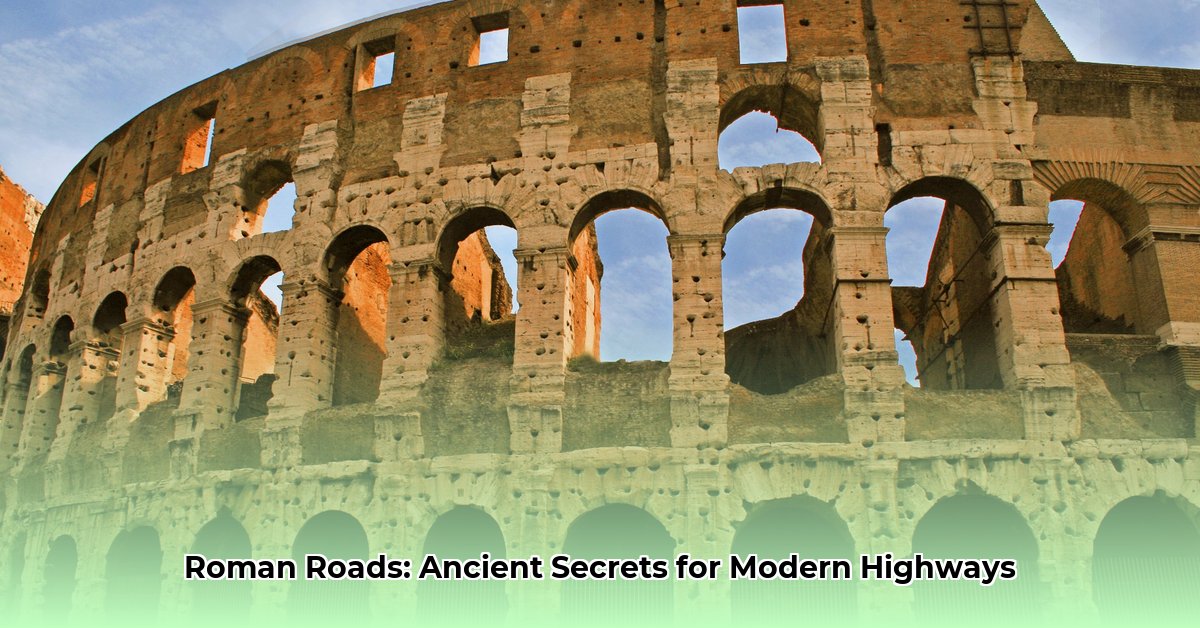Have you ever considered the invisible engineering beneath your feet as you drive on a modern highway? For centuries, the ancient Romans perfected the art of road construction, forging a vast network that remains a testament to their ingenuity, with some sections still in use today. These were not simple dirt tracks but sophisticated engineering marvels, built upon a precise, multi-layered system designed for unparalleled durability and efficiency.
Imagine a meticulously crafted structure, where each component—from robust gravel foundations to advanced concrete and tightly fitted paving stones—served a critical purpose in connecting an empire. Read more about the construction methods. This comprehensive guide unravels the enduring secrets of ancient Roman roads, their intricate layered construction, the logistical genius that powered their vast expansion, and the invaluable lessons they offer for contemporary highway design and civil engineering. Discover what made Roman concrete so formidable, how their drainage systems mirrored modern practices, and why their timeless principles continue to inform the creation of more resilient, sustainable infrastructure in the 21st century.
The Enduring Blueprint: Anatomy of a Roman Road
The remarkable longevity of Roman roads stems directly from their meticulous, layered construction. This systematic approach ensured exceptional stability and resilience, capable of withstanding heavy legionary movements, relentless trade caravans, and centuries of environmental stress. Much like building a robust structure today, the Romans understood that a strong foundation was paramount to long-term performance.
The Romans’ commitment to quality and efficient resource management, as seen in their road construction, highlights principles that modern companies can still learn from to achieve similar levels of sustainable growth and operational excellence; in fact, these principles are critical to scaling your business effectively.
The Roman road network, at its height, spanned an astonishing 400,000 kilometers (approximately 250,000 miles), with over 80,500 kilometers (50,000 miles) paved in stone. This extensive infrastructure was not merely for travel; it was indispensable for military movement, economic prosperity, communication, and maintaining the cultural cohesion of a vast empire.
The Layered System: A Detailed Breakdown
Let’s dissect the distinct layers that formed the spine of the Roman Empire, often spanning a colossal 400,000-kilometer network that was essential for military movement, trade, and cultural cohesion:
Statumen (Foundation): Functioning as the road’s bedrock, the statumen was the inaugural layer. It comprised large, undressed stones, typically 25 to 60 cm (10 to 24 inches) thick. These stones were laid directly on a compacted foundation soil, providing a stable, load-bearing platform. This fundamental layer distributed the immense weight from above evenly across the subgrade, much like the reinforced concrete slab foundation of a modern building, preventing the road from sinking or shifting.
Rudus (Rubble Layer): Superimposed on the statumen was the rudus, a layer approximately 20 cm (8 inches) thick. This consisted of smaller, crushed stones meticulously mixed with lime mortar or, in some variations, gravel and sand. Its primary roles were creating a more even surface for subsequent layers, providing a binding matrix, and further distributing vertical loads. The lime infusion acted as a rudimentary binder, compacting the layer into a more cohesive mass that reduced settlement and resisted displacement under heavy loads.
Nucleus (Concrete Layer): Here lies one of the Roman Empire’s most celebrated engineering innovations. The nucleus constituted a concrete base layer, typically 30 cm (12 inches) thick, distinctively formulated with pozzolana (a highly reactive volcanic ash), lime, and aggregate (sand and gravel). This unique mix created a hydraulic cement that hardened even underwater, offering unparalleled strength and durability. Researchers have recently highlighted the “lime clast” innovation within this concrete, suggesting a self-healing capability that extended its lifespan indefinitely. This layer effectively served as the road’s primary structural element, enduring significant traffic stresses and minimizing vibrations for travelers.
Summum Dorsum / Pavimentum (Paving Stones): The topmost layer, known variously as summum dorsum or pavimentum, consisted of large, polygonal basalt or limestone slabs, approximately 15 cm (6 inches) thick. These were meticulously fitted together to form an even, hard-wearing surface. Their close fit minimized water seepage into the underlying layers and provided an efficient pathway for various forms of ancient transport, from foot traffic to heavy chariots. This layer was designed for maximum wear resistance and easy repair.
The table below summarizes these critical elements:
| Layer Name | Material | Typical Thickness | Primary Purpose |
|---|---|---|---|
| Statumen (Foundation) | Large, Undressed Stones | 25-60 cm (10-24 inches) | Provides a stable and solid sub-base, distributing load. |
| Rudus (Rubble Layer) | Crushed Stone Mixed with Lime (or gravel/sand) | ~20 cm (8 inches) | Creates an even surface, binds materials, further distributes weight, resists displacement. |
| Nucleus (Concrete Layer) | Roman Concrete (Pozzolana, Lime, Aggregate) | ~30 cm (12 inches) | Distributes weight evenly, provides structural integrity, resists deformation, minimizes vibrations. |
| Summum Dorsum/Pavimentum | Tightly Fitted Paving Stones | ~15 cm (6 inches) | Offers a smooth, durable, and weather-resistant surface for travel, protecting lower layers. |
Beyond Layers: Strategic Engineering for Longevity
The Romans’ engineering prowess extended far beyond mere material layering. Their deep understanding of hydrology, topographical planning, and precise surveying techniques contributed significantly to the roads’ enduring performance and strategic value.
Drainage: The Unsung Hero of Road Preservation
One of the most effective yet often overlooked features of Roman roads was their sophisticated drainage system. Roads were intentionally designed with a slight convex curve from the center to the edges, a feature known as a cambered surface or dual slope. This ingenious design allowed rainwater to rapidly run off the road, preventing pooling and subsequent water infiltration into the lower layers, which could undermine the roadbed.
Key drainage elements included:
- Cambered Surface: Raised in the middle, the road sloped gently to either side. This design ensured rapid runoff during storms, reducing wear on the paving stones and foundation layers.
- Ditches: Positioned alongside roads, open channels collected and carried away water that flowed off the cambered surface. They helped protect embankments and adjacent land from saturation and flooding. Pedestrian paths of packed gravel, often 1-3 meters wide, ran alongside these, separated by upright curb slabs.
- Culverts: Roman engineers constructed stone or brick culverts beneath roads to allow natural streams or irrigation channels to pass without interrupting traffic flow. These structures prevented water accumulation that could weaken the roadbed.
- Raised Embankments: In marshy or flood-prone areas, roads were elevated above surrounding terrain, combining with drainage features to ensure durability even in challenging environments.
This comprehensive water management system was vital for preserving the strength of roads over many years. Water is a common enemy of paved surfaces; by effectively managing its movement, Roman engineers minimized damage and reduced maintenance requirements. The cambered design continues to be a fundamental principle in modern road construction.
Precision Alignment and Terrain Management
Roman engineers, known as agrimensores, were masters of route planning and execution. While they famously favored routes that were as straight as possible to facilitate swift troop and supply deployment, they were also remarkably adaptive to challenging terrain. This emphasis on efficient, direct routes underscored their strategic military and logistical objectives.
They relied on highly precise surveying instruments to achieve remarkable accuracy over vast distances:
- Groma: Essential for setting out straight lines and right angles, this instrument consisted of a vertical staff with horizontal cross-pieces and plumb lines. It allowed surveyors to mark exact right angles, enabling the creation of the famously direct Roman roads.
- Chorobates: Used primarily for leveling, this resembled a wooden frame about 6 meters long with a water trough or plumb lines to indicate horizontal level. It helped maintain consistent gradients essential for drainage and stable road surfaces.
- Dioptra: A more advanced tool, the dioptra combined features of a modern theodolite. It measured angles both horizontally and vertically, allowing engineers to plan curves, inclines, and alignments with precision over uneven terrain.
- Hodometer: This distance-measuring device worked like an odometer on a vehicle. Attached to a cart wheel, it counted rotations to calculate distances traveled during surveying. Accurate distance measurement was vital for mapping routes and placing milestones.
When confronted with natural barriers such as rivers, valleys, or mountains, the Romans demonstrated unparalleled ingenuity by constructing impressive arched bridges capable of spanning significant distances and carving tunnels through solid rock. Notable examples include the Pons Fabricius in Rome, which still stands after two millennia. These advanced construction techniques were centuries ahead of their time, ensuring the continuity of their vital network.
Strategic Network and Famous Routes
The Roman road system was designed as the backbone of an empire. Roads allowed legions to move swiftly across vast territories, maintaining control over far-flung provinces and enabling rapid troop deployment (up to 20-25 miles per day) to defend against invasions or quell rebellions. Trade flourished as goods could be transported faster and more reliably between cities and regions. Merchants benefited from a network connecting markets, ports, and production centers, fueling prosperity.
Some of the most famous Roman roads, many of which still influence European geography, include:
- Via Appia (Appian Way): The “Queen of Roads,” constructed in 312 BCE, linking Rome to Capua and eventually Brundisium. It is famous for its remarkably straight lines.
- Via Aurelia: A coastal route extending from Rome to Gaul.
- Via Flaminia: A crucial northward road from Rome to Ariminum (Rimini).
- Via Egnatia: A key route in the Balkans, connecting Dyrrachium (modern Durres) to Byzantium (Istanbul).
- Via Augusta: One of the longest Roman roads, stretching across Hispania (modern Spain), covering over 1,500 km.
These routes connected Rome to its provinces not just physically but also culturally and administratively. The famous saying, “All roads lead to Rome,” truly reflects the geographic centralization and the idea of Rome as the heart of an organized and connected world.
Actionable Insights for Modern Civil Engineering
The ancient Romans left behind an invaluable legacy for today’s civil engineers and construction professionals. By studying their methods, we can glean actionable insights to build more resilient, long-lasting, and sustainable infrastructure in the 21st century.
Concrete Innovation and Durability
The legendary durability of Roman concrete offers profound lessons. The integration of pozzolanic ash, particularly in marine environments, dramatically enhanced its strength and resistance to degradation. More intriguing is the ongoing research into the “lime clast” phenomenon. Recent studies, notably from MIT, suggest that Roman concrete’s hot mixing process, utilizing quicklime, created self-healing properties via these minute lime clasts. These clasts, typically 1-2 mm in size within the concrete matrix, could react with water to mend micro-cracks, significantly extending the material’s lifespan by decades or even centuries.
For modern professionals, this translates into direct applications:
- Investigate Pozzolanic Materials: Actively research and experiment with various types of pozzolans (e.g., fly ash, silica fume, ground granulated blast-furnace slag, natural volcanic ash) and their optimal proportions in modern concrete mixes to enhance strength, reduce permeability, and improve durability, particularly in challenging environments.
- Explore Hot Mixing Techniques: Conduct pilot programs or research into pre-hydrating lime with hot water before mixing with cement. Replicating the high temperatures (potentially 80-90°C) achieved by the Romans could facilitate unique chemical reactions and potentially accelerate setting times, leading to faster construction and enhanced material properties.
- Develop Self-Healing Concrete: Prioritize research and development into incorporating “lime clast” principles, or similar self-repairing mechanisms, into contemporary concrete formulations. This could involve embedding reactive agents or microcapsules within the concrete that activate upon crack formation, significantly extending the lifespan of structures and reducing long-term maintenance costs.
Optimized Layered Construction Principles
The Roman layered approach, which meticulously combined different materials for optimal load distribution and stability, remains a cornerstone of effective road construction. This system prevented cracking and sinking, a testament to its efficacy in managing traffic loads and mitigating environmental stress.
- Implement Optimized Layered Construction: Adapt the Roman multi-layered system (sub-base, base course, surface course) into contemporary road construction projects with precision. This ensures a stable base for the road surface, distributing traffic loads efficiently and enhancing long-term performance. Modern engineers can achieve significantly higher success rates in preventing premature road degradation by adhering to well-designed layered systems that account for soil conditions, traffic volume, and climate.
Effective Drainage Strategies
The Roman’s simple yet highly effective use of a cambered surface for rapid water runoff is a principle that must be rigorously applied today. Water infiltration is a primary cause of road degradation, leading to potholes, cracks, and structural failure.
- Design and Implement Robust Drainage Systems: Ensure all new road projects incorporate precisely calculated cambered surfaces and efficient drainage channels, including ditches, culverts, and proper grading. This minimizes water accumulation on and around the road, preventing subgrade saturation, frost heave, and erosion, thereby significantly enhancing the longevity and safety of roads, especially in regions prone to heavy rainfall or freeze-thaw cycles.
Challenges, Variations, and the Human Element
While the Roman road network was an astonishing achievement, it’s crucial to acknowledge the practicalities and variations involved. There wasn’t a single, monolithic “Roman road” design; specifications varied based on regional material availability, local terrain morphology, geological structure, and the road’s intended purpose (public viae publicae, private viae privatae, or country roads viae rusticae). Public roads, for instance, could range from 6 to 12 meters (20 to 40 feet) wide, while private roads might be 2.5 to 4 meters (8 to 13 feet).
Construction itself was a massive undertaking, requiring a diverse workforce. Skilled engineers and meticulous land surveyors, employing tools like the groma and chorobates for precise alignment, spearheaded the projects. The labor force comprised a mix of civilian workers, local populations, and, significantly, legionaries. Roman legions were exceptionally adept at road and bridge building, often constructing these vital arteries in hostile terrain to facilitate rapid supply delivery and troop maneuverability. It is estimated that a single person could construct between 135 to 180 meters of road per day, though this varied greatly depending on conditions and the complexity of the terrain.
Even with robust construction, maintenance was an ongoing necessity. The concept of “How Roman Roads Were Maintained” involved continuous repairs to address wear and tear from constant use and environmental factors. Special overseers, the curatores viarum, were appointed to monitor the condition of public roads, funded either by the state treasury, local towns, or wealthy benefactors. Milestones (miliaria), beyond simply marking distances (often inscribed with the emperor’s name and the distance from Rome in mille passus or 1,000 paces, roughly one Roman mile), often documented these administrative efforts, underscoring the empire’s commitment to vital infrastructure.
The Imperishable Legacy: Connecting Past to Future
Roman roads were more than just pathways; they were the arteries of an empire, facilitating trade, communication, and military prowess, and are considered one of the most impressive engineering achievements in history. Their enduring presence, often still visible or underlying modern routes (such as England’s Watling Street and Fosse Way), serves as a powerful testament to their ingenious design and construction. By meticulously cracking the code: ancient Roman road layers, we gain invaluable concrete durability insights and learn profound lessons about legion logistics that directly inform contemporary modern highway design.
By embracing these timeless principles—from innovative material science to strategic layered construction and meticulous drainage—civil engineers and construction companies worldwide can pave the way for a future of infrastructure that is not only durable and sustainable but also a lasting legacy for generations to come. Further archaeological and material science research promises to unlock even deeper insights into these ancient engineering marvels, further connecting the ingenuity of the past with the challenges of the future.
Granular Data Comparisons: Concrete Properties
| Feature | Roman Concrete | Modern Portland Cement Concrete |
|---|---|---|
| Pozzolanic Material | Volcanic ash (e.g., from Baia, Cumae), often reactive | Fly ash, silica fume, ground granulated blast-furnace slag |
| Lime Clast Size | 1-2 mm (key to proposed self-healing mechanism through hot mixing) | Not typically present in standard mixes |
| Mixing Temperature | Suspected 80-90°C (hot mixing with quicklime facilitated unique chemistry) | Ambient temperatures |
| Elastic Modulus | Lower (contributes to ductility and crack resistance, allows for slight deformation) | Higher (can lead to more brittle failure under stress) |
| Density | Generally lower (due to porous aggregate) | Generally higher (denser aggregates) |
| Long-Term Durability | Exceptional, often lasting millennia (especially in marine environments) | Dependent on mix design, exposure, and maintenance; typically 50-100 years without major repairs |
(Citation: MIT News. “Revealing the ‘Self-Healing’ Secrets of Roman Concrete.” January 6, 2023. This research highlights the benefits of hot mixing: high temperatures enable chemistries not possible with less reactive slaked lime, and increased temperatures significantly reduce curing and setting times, allowing for faster construction.)
(Further Reading: World History Encyclopedia. “Roman Roads.” Last modified October 20, 2017. This resource offers additional context on the strategic importance and construction of Roman roads, including specific examples and their administrative oversight.)










